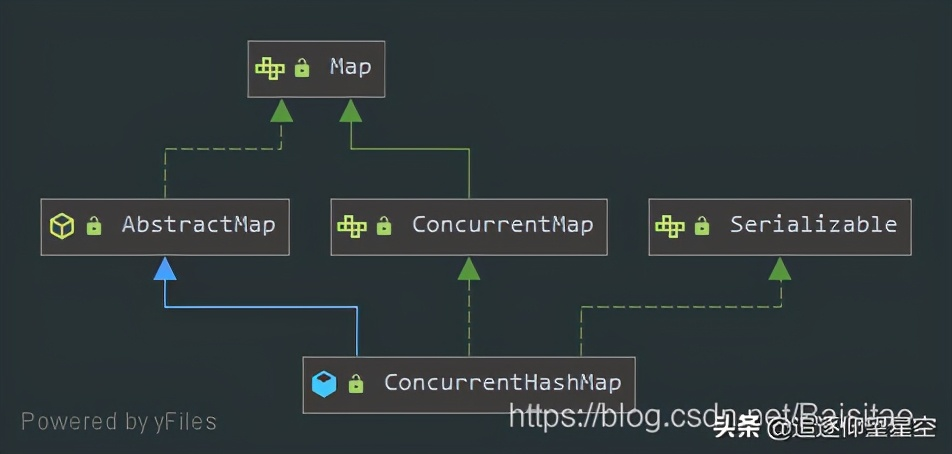前言
HashMap是一个非常优秀的类,使用也非常频繁。唯一的遗憾就是HashMap不是线程安全的。理解了HashMap,再来看ConcurrentHashMap会有事半功倍的效果,因为ConcurrentHashMap底层数据结构、核心方法几乎和HashMap一模一样,只是在多线程环境下做了很多保证线程安全的操作。JDK早期提供了线程安全的HashMap类,那就是Hashtable,底层几乎把所有的方法都加上了锁,导致效率太低。JDK1.5开始,JUC包中提供了一个更高效的、线程安全的HashMap类,那就是ConcurrentHashMap。
ConcurrentHashMap

可以看到ConcurrentHashMap主要实现了Map和Serializable接口。
内部结构
想要读懂容器类的源码,必须先了解它的数据结构。所以先看看ConcurrentHashMap的内部结构,重点关注以下几个中的属性即可:
public class ConcurrentHashMap<K,V> extends AbstractMap<K,V>
implements ConcurrentMap<K,V>, Serializable {
private static final long serialVersionUID = 7249069246763182397L;
// 最大容量
private static final int MAXIMUM_CAPACITY = 1 << 30;
// 默认容量
private static final int DEFAULT_CAPACITY = 16;
// 最大可能的数组大小
static final int MAX_ARRAY_SIZE = Integer.MAX_VALUE - 8;
// 默认的并发级别(不使用,为了兼容之前的版本)
private static final int DEFAULT_CONCURRENCY_LEVEL = 16;
// 默认加载因子
private static final float LOAD_FACTOR = 0.75f;
// 链表转红黑树阈值
static final int TREEIFY_THRESHOLD = 8;
// 红黑树退化成链表的阈值
static final int UNTREEIFY_THRESHOLD = 6;
// (红黑)树化时,table数组最小值
// 至少是4倍的TREEIFY_THRESHOLD
static final int MIN_TREEIFY_CAPACITY = 64;
// 第一次新增元素时初始化,始终是2的幂
transient volatile Node<K,V>[] table;
// 扩容时用,代表扩容后的数组
private transient volatile Node<K,V>[] nextTable;
// 节点hash的特殊值
static final int MOVED = -1; // 转移节点的hash值
static final int TREEBIN = -2; // (红黑)树根节点的hash值
static final int RESERVED = -3; // 临时保留的hash值
static final int HASH_BITS = 0x7fffffff; // 普通节点hash的可用位
// 控制table初始化和扩容的字段
// -1 初始化中
// -n 表示n-1个线程正在扩容中
// 0 使用默认容量进行初始化
// >0 使用多少容量
private transient volatile int sizeCtl;
}构造方法
ConcurrentHashMap提供了5个构造方法,主要关注3个
public ConcurrentHashMap(int initialCapacity) {
if (initialCapacity < 0)
// 传入的初始化容量不能小于0
throw new IllegalArgumentException();
// 根据传入的capacity计算合理的capacity
int cap = ((initialCapacity >= (MAXIMUM_CAPACITY >>> 1)) ?
MAXIMUM_CAPACITY :
tableSizeFor(initialCapacity + (initialCapacity >>> 1) + 1));
this.sizeCtl = cap;
}
public ConcurrentHashMap(int initialCapacity, float loadFactor) {
// concurrencyLevel传入了1
this(initialCapacity, loadFactor, 1);
}
public ConcurrentHashMap(int initialCapacity,
float loadFactor, int concurrencyLevel) {
if (!(loadFactor > 0.0f) || initialCapacity < 0 || concurrencyLevel <= 0)
// loadFactor、initialCapacity、concurrencyLevel都不能小于0
throw new IllegalArgumentException();
if (initialCapacity < concurrencyLevel) // Use at least as many bins
initialCapacity = concurrencyLevel; // as estimated threads
long size = (long)(1.0 + (long)initialCapacity / loadFactor);
// 根据传入的capacity和loadFactor计算合理的capacity
int cap = (size >= (long)MAXIMUM_CAPACITY) ?
MAXIMUM_CAPACITY : tableSizeFor((int)size);
this.sizeCtl = cap;
}构造方法基本只做了参数校验,计算合理的capacity值,并没有初始化数组table
核心方法
对于ConcurrentHashMap而言,核心方法毫无疑问就是put和get。所以先来看看put方法的整体逻辑。
put方法
put方法用于往map中添加一个键值对K、V。方法实现如下:
public V put(K key, V value) {
// 调用自身putVal()方法
// 第三个参数传false,表示map中有相同的key时(equals相等),直接覆盖其value值
return putVal(key, value, false);
}
/** Implementation for put and putIfAbsent */
final V putVal(K key, V value, boolean onlyIfAbsent) {
// key、value都不能为null
if (key == null || value == null) throw new NullPointerException();
// 计算hash值
int hash = spread(key.hashCode());
int binCount = 0;
for (Node<K,V>[] tab = table;;) {
// 自旋
Node<K,V> f;
int n, i, fh;
if (tab == null || (n = tab.length) == 0)
// 数组尚未初始化,进行初始化
tab = initTable();
else if ((f = tabAt(tab, i = (n - 1) & hash)) == null) {
// 当前槽为null(没有数据)
if (casTabAt(tab, i, null,
new Node<K,V>(hash, key, value, null)))
// CAS的方法把k、v包装成Node节点,放在这个槽上
// 成功后就结束自旋,无需加锁
// 不成功继续自旋
break; // no lock when adding to empty bin
}
else if ((fh = f.hash) == MOVED)
// 当前槽上的节点正在转移(扩容)
tab = helpTransfer(tab, f);
else {
// 当前槽上有值,并且不处于转移状态
V oldVal = null;
synchronized (f) {
// 锁住当前槽
// 因为只锁住了一个槽(链表头节点、红黑树根节点),也就是数组的一项,所以比JDK1.7中锁住一段(分段锁)的效率更高
if (tabAt(tab, i) == f) {
// 当前槽上的节点没有被修改过,double-check
if (fh >= 0) {
// 该槽上是单链表
binCount = 1;
for (Node<K,V> e = f;; ++binCount) {
// 遍历当前槽
K ek;
if (e.hash == hash &&
((ek = e.key) == key ||
(ek != null && key.equals(ek)))) {
// 单链表上找到了相同的key,覆盖其value值
oldVal = e.val;
if (!onlyIfAbsent)
e.val = value;
break;
}
Node<K,V> pred = e;
if ((e = e.next) == null) {
// 【尾插法】把新增节点插入链表,退出自旋
pred.next = new Node<K,V>(hash, key,
value, null);
break;
}
}
}
else if (f instanceof TreeBin) {
// 当前槽上存的是红黑树,按照红黑树的方式插入元素
Node<K,V> p;
binCount = 2;
if ((p = ((TreeBin<K,V>)f).putTreeVal(hash, key,
value)) != null) {
oldVal = p.val;
if (!onlyIfAbsent)
p.val = value;
}
}
}
}
if (binCount != 0) {
if (binCount >= TREEIFY_THRESHOLD)
// 链表需要转换成红黑树
treeifyBin(tab, i);
if (oldVal != null)
return oldVal;
break;
}
}
}
// 检检查是否需要扩容,如果需要就扩容
addCount(1L, binCount);
return null;
}整个put方法大致分为以下几步:
1、校验K、V,并计算has值
2、进入自旋,判断table是否已经初始化,如果否,则进行初始化;如果是,执行3
3、判断当前槽上是否为null,如果是,通过CAS的方式新增节点;如果否,执行4
4、判断当前槽上的节点是否正在转移(扩容过程),如果是,辅助扩容;如果否,执行5
5、锁住当前槽,如果当前槽上是单链表,按照单链表的方式新增节点,如果是红黑树,按照红黑树的方式新增节点
6、判断链表是否需要转换成红黑树,如果是,转换成红黑树
7、新增节点完成后,检测是否需要扩容,如果需要,就扩容
从源码来看,ConcurrentHashMap中的put方法和HashMap的put方法执行的逻辑相差无几。只是利用了自旋 + CAS、Synchronized等来保证线程安全。
接下来深入put方法中使用的一些内部方法:initTable、addCount等
initTable
initTable用于初始化table数组,其实现如下:
private final Node<K,V>[] initTable() {
Node<K,V>[] tab; int sc;
while ((tab = table) == null || tab.length == 0) {
// 自旋
// 外层putVal方法已经判断过这个条件,double-check
if ((sc = sizeCtl) < 0)
// 有其他的线程正在初始table数组
Thread.yield(); // lost initialization race; just spin
else if (U.compareAndSwapInt(this, SIZECTL, sc, -1)) {
// CAS的方式抢到锁
try {
if ((tab = table) == null || tab.length == 0) {
// 再次double-check
// 执行初始
int n = (sc > 0) ? sc : DEFAULT_CAPACITY;
@SuppressWarnings("unchecked")
Node<K,V>[] nt = (Node<K,V>[])new Node<?,?>[n];
table = tab = nt;
sc = n - (n >>> 2);
}
} finally {
sizeCtl = sc;
}
break;
}
}
return tab;
}初始化table数组的核心逻辑只有一行new操作,但是为了保证线程安全和高效,采用了double-check + 自旋 + CAS的方式,这也是多线程并发编程的常见手段。
addCount
addCount方法用来检测是否需要扩容,如果需要就扩容。
private final void addCount(long x, int check) {
CounterCell[] as; long b, s;
if ((as = counterCells) != null ||
!U.compareAndSwapLong(this, BASECOUNT, b = baseCount, s = b + x)) {
CounterCell a; long v; int m;
boolean uncontended = true;
if (as == null || (m = as.length - 1) < 0 ||
(a = as[ThreadLocalRandom.getProbe() & m]) == null ||
!(uncontended =
U.compareAndSwapLong(a, CELLVALUE, v = a.value, v + x))) {
fullAddCount(x, uncontended);
return;
}
if (check <= 1)
return;
s = sumCount();
}
if (check >= 0) {
Node<K,V>[] tab, nt; int n, sc;
while (s >= (long)(sc = sizeCtl) && (tab = table) != null &&
(n = tab.length) < MAXIMUM_CAPACITY) {
int rs = resizeStamp(n);
if (sc < 0) {
if ((sc >>> RESIZE_STAMP_SHIFT) != rs || sc == rs + 1 ||
sc == rs + MAX_RESIZERS || (nt = nextTable) == null ||
transferIndex <= 0)
break;
if (U.compareAndSwapInt(this, SIZECTL, sc, sc + 1))
// 有别的线程正在扩容
transfer(tab, nt);
}
else if (U.compareAndSwapInt(this, SIZECTL, sc,
(rs << RESIZE_STAMP_SHIFT) + 2))
// 没有别的线程正在扩容
transfer(tab, null);
s = sumCount();
}
}
}对于这个方法而言,就是判断要不要扩容,而真正的扩容方法是transfer,所以具体看下transfer方法的实现逻辑
/**
* tab表示扩容前的数组
* nextTab表示扩容后的新数组(如果为null,表示并没有别的线程在扩容)
*/
private final void transfer(Node<K,V>[] tab, Node<K,V>[] nextTab) {
int n = tab.length, stride;
if ((stride = (NCPU > 1) ? (n >>> 3) / NCPU : n) < MIN_TRANSFER_STRIDE)
stride = MIN_TRANSFER_STRIDE; // subdivide range
if (nextTab == null) { // initiating
try {
// 初始化nextTab,大小为原数组的2倍
@SuppressWarnings("unchecked")
Node<K,V>[] nt = (Node<K,V>[])new Node<?,?>[n << 1];
nextTab = nt;
} catch (Throwable ex) { // try to cope with OOME
sizeCtl = Integer.MAX_VALUE;
return;
}
nextTable = nextTab;
transferIndex = n;
}
// 获取新数组的长度
int nextn = nextTab.length;
// 如果元素组槽上是转移节点,表示该槽上的节点正在转移
ForwardingNode<K,V> fwd = new ForwardingNode<K,V>(nextTab);
boolean advance = true;
boolean finishing = false; // to ensure sweep before committing nextTab
for (int i = 0, bound = 0;;) {
// 自旋
Node<K,V> f; int fh;
while (advance) {
int nextIndex, nextBound;
if (--i >= bound || finishing)
advance = false;
else if ((nextIndex = transferIndex) <= 0) {
// 拷贝已经完成
i = -1;
advance = false;
}
else if (U.compareAndSwapInt
(this, TRANSFERINDEX, nextIndex,
nextBound = (nextIndex > stride ?
nextIndex - stride : 0))) {
bound = nextBound;
i = nextIndex - 1;
advance = false;
}
}
if (i < 0 || i >= n || i + n >= nextn) {
// 拷贝结束
int sc;
if (finishing) {
nextTable = null;
table = nextTab;
sizeCtl = (n << 1) - (n >>> 1);
return;
}
if (U.compareAndSwapInt(this, SIZECTL, sc = sizeCtl, sc - 1)) {
if ((sc - 2) != resizeStamp(n) << RESIZE_STAMP_SHIFT)
return;
finishing = advance = true;
i = n; // recheck before commit
}
}
else if ((f = tabAt(tab, i)) == null)
advance = casTabAt(tab, i, null, fwd);
else if ((fh = f.hash) == MOVED)
advance = true; // already processed
else {
synchronized (f) {
// 加锁,进行节点拷贝
if (tabAt(tab, i) == f) {
// 低位链表和高位链表(前文HashMap中讲过)
Node<K,V> ln, hn;
if (fh >= 0) {
int runBit = fh & n;
Node<K,V> lastRun = f;
for (Node<K,V> p = f.next; p != null; p = p.next) {
int b = p.hash & n;
if (b != runBit) {
runBit = b;
lastRun = p;
}
}
if (runBit == 0) {
ln = lastRun;
hn = null;
}
else {
hn = lastRun;
ln = null;
}
for (Node<K,V> p = f; p != lastRun; p = p.next) {
// 循环拷贝链表节点
// 原数组中的链表会被分成高、低位两个链表,放在新数组中不同的槽
int ph = p.hash; K pk = p.key; V pv = p.val;
if ((ph & n) == 0)
ln = new Node<K,V>(ph, pk, pv, ln);
else
hn = new Node<K,V>(ph, pk, pv, hn);
}
// 链表设置到新数组
setTabAt(nextTab, i, ln);
setTabAt(nextTab, i + n, hn);
// 旧数组上设置转移节点
// 其他线程发下槽上是转移节点后就会等待
setTabAt(tab, i, fwd);
advance = true;
}
else if (f instanceof TreeBin) {
// 拷贝红黑树的节点
TreeBin<K,V> t = (TreeBin<K,V>)f;
TreeNode<K,V> lo = null, loTail = null;
TreeNode<K,V> hi = null, hiTail = null;
int lc = 0, hc = 0;
for (Node<K,V> e = t.first; e != null; e = e.next) {
int h = e.hash;
TreeNode<K,V> p = new TreeNode<K,V>
(h, e.key, e.val, null, null);
if ((h & n) == 0) {
if ((p.prev = loTail) == null)
lo = p;
else
loTail.next = p;
loTail = p;
++lc;
}
else {
if ((p.prev = hiTail) == null)
hi = p;
else
hiTail.next = p;
hiTail = p;
++hc;
}
}
ln = (lc <= UNTREEIFY_THRESHOLD) ? untreeify(lo) :
(hc != 0) ? new TreeBin<K,V>(lo) : t;
hn = (hc <= UNTREEIFY_THRESHOLD) ? untreeify(hi) :
(lc != 0) ? new TreeBin<K,V>(hi) : t;
setTabAt(nextTab, i, ln);
setTabAt(nextTab, i + n, hn);
setTabAt(tab, i, fwd);
advance = true;
}
}
}
}
}
}可以看到ConcurrentHashMap中的扩容也是采用了自旋 + CAS + Synchronized来保证线程安全的,除此之外,还添加了转移节点,表示该槽上的节点正在被转移,此时别的线程不要往这个槽写数据。
get方法
get方法用于从map中根据key取value。其实现相比于put方法要简单得多
public V get(Object key) {
Node<K,V>[] tab; Node<K,V> e, p; int n, eh; K ek;
// 根据key计算hash值
int h = spread(key.hashCode());
if ((tab = table) != null && (n = tab.length) > 0 &&
(e = tabAt(tab, (n - 1) & h)) != null) {
// table不为空,且当前槽上有数据
if ((eh = e.hash) == h) {
if ((ek = e.key) == key || (ek != null && key.equals(ek)))
// 槽上第一个节点就是要取的节点,直接返回value
return e.val;
}
else if (eh < 0)
// 槽上的第一个节点红黑树的根节点或者转移节点,调用其find方法查找
return (p = e.find(h, key)) != null ? p.val : null;
while ((e = e.next) != null) {
// 槽上是单链表,遍历单查找
if (e.hash == h &&
((ek = e.key) == key || (ek != null && key.equals(ek))))
// 找到需要的节点,返回value
return e.val;
}
}
// table没有初始
// 当前槽上没有数据
// 红黑树/转移节点/单链表上未找到
return null;
}size方法
size方法用于返回map的节点个数,在HashMap中非常简单,因为定义了一个变量来维护size,但是ConcurrentHashMap并没有定义这样的变量,先来看下其size方法的实现
public int size() {
// 调用内部sumCount方法
long n = sumCount();
return ((n < 0L) ? 0 :
(n > (long)Integer.MAX_VALUE) ? Integer.MAX_VALUE :
(int)n);
}
final long sumCount() {
CounterCell[] as = counterCells; CounterCell a;
long sum = baseCount;
if (as != null) {
for (int i = 0; i < as.length; ++i) {
if ((a = as[i]) != null)
sum += a.value;
}
}
return sum;
}可以看到最后返回size的值就是baseCount的值 + counterCells数组中的所有值之和。
counterCells数组中存的实际上就是table数组中每个槽上的节点个数。
baseCount相当于counterCells的优化,在没有竞争的时候使用。
实际上也就是分段求和,再汇总的思想。
看到方法内部并没有加锁,说明size方法返回的并不是一个准确值,而是一个近似值,因为在汇总的过程中,有可能map中新增或者删除了元素。
与JDK1.7的区别

一张图就可以直观的感受到ConcurrentHashMap在JDK1.7和JDK1.8的区别
对JDK1.7中的ConcurrentHashMap而言
内部主要是一个Segment数组,而数组的每一项又是一个HashEntry数组,元素都存在HashEntry数组里。因为每次锁定的是Segment对象,也就是整个HashEntry数组,所以又叫分段锁。
对JDK1.8中的ConcurrentHashMap而言
舍弃了分段锁的实现方式,元素都存在Node数组中,每次锁住的是一个Node对象,而不是某一段数组,所以支持的写的并发度更高。
再者它引入了红黑树,在hash冲突严重时,读操作的效率更高。
这两点便是JDK1.8对ConcurrentHashMap所做的主要优化。
总结
ConcurrentHashMap类的实现,可以说是并发容器中,经典中的经典。深入的理解这个类,需要数据结构的基础,以及并发编程的基础。


评论 (0)